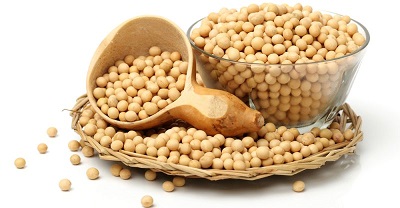Fact sheet about legume in Ghana

It is fascinating to note that:
- was released in 1992. It has medium maturing attribute, resistant to shattering, seed colour is cream, maturity period is 105-115 days and it yields 1.2 to 1.8 ton/h. Anidaso is applicable in Guinea Savanna, Sudan Savanna, transition and coastal Savanna zones. It can be processed for oil; can be used as meal for the animal feed industry; can be processed for human consumption and made into products including soy milk, soy flour, soy protein, tofu and many retail food products. Soybeans are also used in many non-food (industrial) products.
- was released in 1992. Its seed coat colour is cream, matures in 100-110 days, yields 1.8 t/ha. It is suitable for Guinea Savanna, Sudan Savanna, transition and coastal zones. It can be processed for oil; it can be used as meal for the animal feed industry; can be processed for human consumption and made into products including soy milk, soy flour, soy protein, tofu and many retail food products. Soybeans are used also in many non-food (industrial) products.
- was released in 2005. It has early-maturing attribute, has bold and creamy seed, tolerant to lodging, it is early-maturing (89-93 days), tolerant to major virus diseases of soybean in Ghana and has seed yield of 2.1t/ha. CRI-Nangbaar is applicable in Guinea Savanna, Sudan Savanna, transition and coastal Savanna zones. It can be processed for their oil: it can be used as meal for the animal feed industry; can be processed for human consumption and made into products including soy milk, soy flour, soy protein, tofu and many retail food products. Soybeans are also used in many non-food (industrial) products.
- was released in 2005. It has early-maturing (92-97 days) attribute, cream in colour, moderately resistant to virus, anthracnose. It is high-yielding (2.4 t/ha). CRI-Ahoto is suitable forGuinea Savanna, Sudan Savanna, transition and coastal Savanna zones. It can be processed for their oil; can be used as meal for the animal feed industry; can be processed for human consumption and made into products including soy milk, soy flour, soy protein, tofu and many retail food products. Soybeans are used also in much non-food.
- was released in 2018. Matures in 101 days, resistant to soybean rust disease, has yield potential of 3.4t/ha. It is resistant to pod shattering, it has stay-green trait, tolerant to drought even in the face of severe drought and resistant to lodging. It is applicable in Savanna and the forest-Savanna transition zones. It can be processed for oil; can be used as meal for the animal feed industry; can be processed for human consumption and made into products including soy milk, soy flour, soy protein, tofu and many retail food products. Soybeans are used also in many non-food (industrial) products.
- was released in 2018. It has high number of branches per plant, high number of pods per peduncle, resistant to lodging and the soybean rust disease and potential yield of 3.5t/ ha. CRI-Toondana is suitable for Savanna and the forest-Savanna transition zones. It can be processed for oil; can be used as meal for the animal feed industry; can be processed for human consumption and made into products including soy milk, soy flour, soy protein, tofu and many retail food products. Soybeans are used also in many non-food (industrial) products.
- soya bean variety was released in 1985. Its maturity period is 15 days, yield potential is 2.4 t/ha, susceptible to shattering, seed colour is cream, easy to thresh, excellent seed quality, good yield across many locations, tolerant to bacterial pustule and Cercospora leaf spot and good trap crop for Striga hermonthica. It is applicable in Guinea and Sudan Savanna, and transitional zone. It can be processed for oil; can be used as meal for the animal feed industry; can be processed for human consumption and made into products including soy milk, soy flour, soy protein, tofu and many retail food products. Soybeans are used also in many non-food (industrial) products.
- soya bean variety was released in 1985. It matures in 130 days, yield potential is 2.8 t/ha, seed colour is cream, susceptible to shattering, stable yield, easy to thresh, excellent seed quality and tolerant to common soy[1]bean pests and diseases. It is suitable for Guinea and Sudan Savanna, and transitional zone. It can be processed for oil; can be used as meal for the animal feed industry; can be processed for human consumption and made into products including soy milk, soy flour, soy protein, tofu and many retail food products. Soybeans are used also in many non-food (industrial) products.
- was released in 2003. Yield potential is 2.5-2.8 t/ ha, resistant to pod shattering (up to 3% shattering), medium maturity (110-115 days), seed colour is cream, excellent seed quality, high and stable yield across many environments, tolerant to common soy[1]bean pests and diseases, relatively tolerant to low soil P and trap-crop for Striga hermonthica. It is applicable in Guinea and Sudan Savanna, transitional and forest zones. It can be processed for oil; can be used as meal for the animal feed industry; can be processed for human consumption and made into products including soy milk, soy flour, soy protein, tofu and many retail food products. Soybeans are used also in many non-food (industrial) products.
Source: Manual of Agricultural Technologies
developed by CSIR, MAG and MoFA.
Page 56-61
#######














